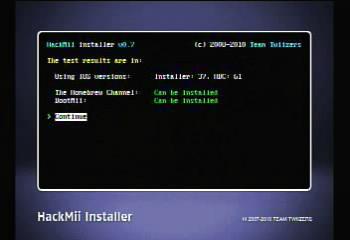No Installer.elf In Hackmii
Posted By admin On 25.10.19If you get this error when running the HackMii Installer it means you are either using an old version of the HackMii Installer. Rename 'HackMii.elf' to 'boot.elf'. HackMii Installer (v0.7). Tried Hackmii: No way. Tried to load the hbc as dol, but I always get an non-gui-installer and the installation canceled.
My Wii was accidently updated with Wii ver 4.2U and Homebrew applications were deleted from system.As per instructes on the website, I tried to install Bannerbomb v2As instructed in Bv2, I download abd6av200.zip and unzip it onto the SD card.The next step I had a problem: Go download the HackMii installer. Copy installer.elf to the root of the SD card, and rename it to boot.elf.I could not find “installer.elf” anywhere; however there was a boot.elf.I used the boot.elf and put it on the root of my SD card.The next instruction was to: Press the SD card icon (for the SD menu). Then insert the card. It should either pop up Load boot.dol/elf?
Or freeze.It did neitherI then tried abd6bv200.zip and replaced the “content.bin” on my Sd card and tried again. Like the first time it did nothing.Can you help. What am I doing wrong?
See also: BootMiiGeneralAuthor(s)Version1.5LinksPeripheralsWarning!This homebrew makes permanent changes to your Wii's flash memory (NAND) and should be used with caution.BootMii is a system designed by to enable complete low-level control of the Wii. It allows the Wii to be controlled mere moments after the On button has been pressed, before any has been loaded and before the filesystem has been read. BootMii can be launched from the from the menu that pops up when the home button is pressed. Contents.ControlsFamily Trainer PadActionminusPrevious OptionBlue DownNext optionOrange SquareSelect optionArchitectureBootMii is comprised by four pieces of software:.
Installer - This is a simple ELF file which may be run using your favorite method (HBC, or any other exploit which can load standard executables). It checks your Wii to make sure it can safely be modified, saves some vital data for disaster recovery, and installs the rest of the components. Loader stub - This is a small bit of ARM code which is injected into, replacing Nintendo's internal ELF loader. When run, it looks to see if an SD card is inserted. If so, it tries to load and execute /bootmii/armboot.bin instead of boot2. Otherwise, it will fall back to loading boot2.
This is a rudimentary replacement for IOS that is best suited for low-level recovery functions. Source code is available under GPLv2. BootMii (or bootmii-ppc) - When mini runs, it looks for a file named /bootmii/ppcboot.elf on the SD card.

No Installer.elf In Hackmii 2017
If it exists, mini loads this executable into memory, boots up the (ppc) and executes that binary in parallel with mini. Source code is available under GPLv2 at (tbd).Both mini and bootmii-ppc must be present in order to draw a user interface, because the cannot directly access the.BenefitsBootMii allows anything from Recovery modes (creating a practically unbrickable Wii), to lazy access of the. For example, if you have corrupted the, you can use to reinstall the. Unfortunately, all homebrew currently require an, because requires one.
However, there is (a homebrew IOS-like software), which can be modified specifically for the program, ie, for better communication to the Linux kernel.How it worksBootMii is a modified version of, which is loaded by, which is loaded. Boot0 is part of and read-only. Boot1, although stored on the, is signed by a value in write-once memory and therefore cannot be changed without rendering a console unable to boot. Boot2, however, can be modified (with some restrictions). This means it can be hacked, updated, and corrupted.
BootMii hijacks the before the normal boot2 is run, optionally allowing code to be run directly from the SD Card. This has many advantages, such as making it very difficult to, and slowing Nintendo from blocking homebrew. Unfortunately, the only way we could completely stop Nintendo from blocking homebrew is by patching updates on-the-fly, or somehow preventing overwriting boot2. Along with the update, Nintendo released a new version of boot2 (boot2v4); there is nothing in boot2v4 that prevents BootMii from working, but it will overwrite an existing BootMii installation when it is installed.CompatibilityBootMii should be compatible with most Wiis released before late 2008.
The Dell Support Utility is customized for your computing environment.Dell Support Utility, and view Dell Support settings. NOTE: If the Dell Support Utility is not available from the Start menu, go to support.dell.com and download the software. Free download driver dell vostro 220.
Please Hackmii Download
Support for newer Wiis (with reduced functionality) will have to install BootMii as an IOSFor an SD card compatibility list, See.Required hardwareBootMii will not require any special hardware. However, special hardware might help accomplish things that BootMii by itself cannot, such as hardware NAND write protection and isolation from the Nintendo software stack. No such hardware exists yet though.The new boot1Consoles made after some point in 2008 (no concrete date is known) have a new version of that patches the vulnerability which allows the console to boot a modified. The Hackmii Installer will detect this situation and refuse to modify boot2(see more at ).
Since boot1 cannot be updated, all consoles already manufactured before this update are safe. About 10% of the consoles that ran the BootMii Checker tool have the new boot1.Console Keys and keys.binInstead of using, you can retrieve your console keys from the keys.bin file that BootMii v3+ produces when backing up the. To view them, open keys.bin with a hex editor.Here are the offsets for each key:boot1 hash: 0x100 (20 bytes)Common key (AES): 0x114 (16 bytes)Console ID: 0x124 (4 bytes)ECC Private Key: 0x128 (30 bytes)NAND HMAC: 0x144 (20 bytes)NAND AES key: 0x158 (16 bytes)PRNG seed (AES): 0x168 (16 bytes)ngkeyid: 0x208 (4 bytes)ngsig: 0x20c (60 bytes)For a full description of the purpose of each key, see.Media. Click for larger image.Video source: 's early BootMii demo.